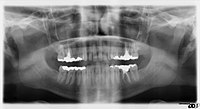
Photo from wikipedia
OBJECTIVES To assess the validity of digital panoramic radiographs as an effective means of diagnosis for atherosclerosis and as a potential aid in the early detection of the disease. STUDY… Click to show full abstract
OBJECTIVES To assess the validity of digital panoramic radiographs as an effective means of diagnosis for atherosclerosis and as a potential aid in the early detection of the disease. STUDY DESIGN We reviewed 2014 digital panoramic radiographs taken throughout 2012 and 2013 to identify the presence of calcified atherosclerotic plaques of both female and male patients all aged over 18 years. In addition the medical records of these patients were reviewed in order to establish if there were any predisposing risk factors for atherosclerosis. Statistical analysis was performed to identify any possible link between radiographic atherosclerotic plaques and predisposing risk factors for atherosclerosis using univariate and multivariate models. Statistical significance criteria was defined as P<0.05. RESULTS Out of 2014 patients (1149 female and 865 male), 191 (9.5%) were determined to have calcified atherosclerotic plaques on panoramic radiography. There was a statistically significant relationship between the presence of calcified atherosclerotic plaques and the established risk factors of atherosclerosis such as gender (OR=2.39, P<0.001), age (OR=1.5, P<0.001), stroke (OR=5.38, P<0.001) and hypertension (OR=2.11, P<0.001). CONCLUSION To our knowledge this is the largest study investigating atherosclerotic plaques on digital panoramic radiographs ever carried out in Portugal. Dental practitioners need to be aware of these incidental findings and to consider referring these patients for further investigations to confirm diagnosis.
Journal Title: Journal of stomatology, oral and maxillofacial surgery
Year Published: 2018
Link to full text (if available)
Share on Social Media: Sign Up to like & get
recommendations!